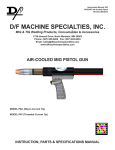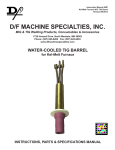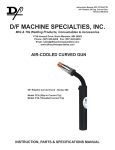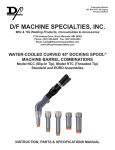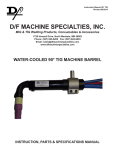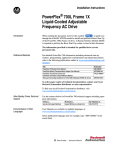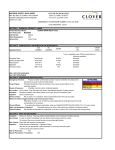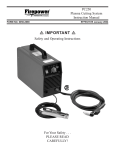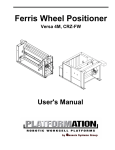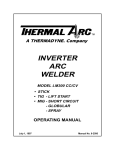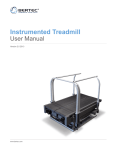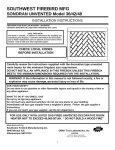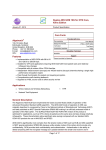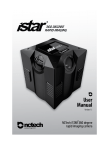Download Instruction Manual 599 - D/F Machine Specialties, Inc.
Transcript
Instruction Manual 599 NCM-WC-T/HTM-WC-T Revised 07/2014 D/F MACHINE SPECIALTIES, INC. MIG & TIG Welding Products, Consumables & Accessories 1750 Howard Drive, North Mankato, MN 56003 Phone: (507) 625-6200 Fax: (507) 625-6203 www.dfmachinespecialties.com WATER-COOLED-TO-THE-TIP MACHINE BARRELS 5” & 8” Standard Nozzles A5” & A8” Series A High Capacity Nozzles DIRECT MOUNT DOCKING SPOOL®/WATER-COOLED-TO-THE-TIP MODEL NCM-W/C-T (Slip-In Tip) MODEL HTM-W/C-T (Threaded Tip) INSTRUCTIONS, PARTS & SPECIFICATIONS MANUAL D/F MACHINE SPECIALTIES is a world leader in the design, development, and manufacture of “MIG” (GMAW) & “TIG” (GTAW) welding products, consumables and accessories. D/F offers several types of manual Air or Water-Cooled “MIG” welding tools, and with the increased use of automated and robotic welding systems, a demand has been created for welding tools of the highest quality, durability and interchangeability. For over forty years, D/F welding products have been used extensively on “MIG” and “TIG” welding applications. This experience, coupled with patented design features, unavailable on any other competitive equipment, has made D/F welding tools the most advanced “MIG” and “TIG” welding guns and barrels for semi-automatic, automatic or robotic welding applications. This Catalog is a guide to helping you select the proper tool for a given semi-automatic, automatic or robotic welding application. The following is only a partial listing of available semi-automatic, automatic and robotic guns. For further information on special “MIG” and “TIG” requirements, please consult the factory. Customer satisfaction and customer benefits are the center points of all strategic contents The spirit of the D/F Machine Specialties personnel is to listen to and to integrate the customer throughout the process, to develop and design marketable products, to present prototypes, to carry out pilot tests and to prepare for and be open to new technology and tasks. We attract and carefully select talented individuals who share our values. Together we will nurture and sustain a work environment with two-way communication, training, mentoring, and rewarding career opportunities. Innovation and quality Innovation and quality come from being receptive and willing to learn from others. We encourage our people to be creative and take risks in the pursuit of excellence. Innovative practices are deeply rooted in every one of our employees, a philosophy that leads to continuous product development and industry firsts. Progress By remaining confident, focused, and persistent in challenging times, we will discover opportunity. Commitment to quality and the pursuit on innovation ensure that D/F Machine Specialties will remain an industry leader for years to come. Commitment to excellence At D/F Machine Specialties we commit to design, build and deliver premium products and superior customer support to quality driven welding professionals. Customers still to this day choose D/F over competitors because of our responsiveness and flexibility. Customers will continue to choose D/F tomorrow for our superior hand-made products and service. To ensure this, we need creative and competent personnel in all business divisions, an intensive exchange of thoughts and ideas with all users, participation in working and study groups within the field of welding technology and intensive cooperation with institutes and universities. Teamwork Striving for excellence is a commitment that is an integral component of the D/F Culture. Our team of skilled and dedicated employees takes pride in the excellence products they produce. Each of us willingly accepts personal responsibility for meeting our commitments and we hold each other to a high standard of accountability. Responsibility We will continually strive to be environmentally responsible and to support the health and safety of our employees, customers, and neighbors. We continue to support the communities in which we operate and the industries in which we participate. Thank You for Choosing D/F Machine Specialties Table Of Contents Introduction, (Table 1) Spare Parts, (Table 2) Gas Nozzles...........................................5 Required Tools List for Disassembly & Assembly........................................................6-7 How Do I Cut, Fit, and Install a New Liner?...................................................................8 What is the Proper Use of the Nozzle Thread Chaser Tap?...........................................9 Disassembly, Assembly................................................................................................10 Direct Mount Machine Barrels - 5” & 8” - Parts............................................................ 11 Direct Mount Machine Barrels - A5” & A8” - Parts........................................................12 (Table 3) Current Tips...................................................................................................13 Complete Assemblies & Utilities - NCM (Slip-In Current Tip).......................................14 Complete Assemblies & Utilities - HTM (Threaded Current Tip)..................................15 Utility Station................................................................................................................16 Transfer Fitting (D/F #40025) Installation.....................................................................17 Feeder Adapters...........................................................................................................18 Troubleshooting.......................................................................................................19-22 SAFETY MEASURES - **PLEASE READ!** Welding is not particularly hazardous when certain safety practices are followed. Anyone using this equipment should be thoroughly trained in safe welding practices. Failure to observe safe practices may cause serious injury. Handling welding torches presents no danger if the appropriate safety regulations are strictly adhered to. For example: • Starting-up procedures must be reserved for those fully conversant with processes relating to arc welding equipment. • Arc welding can prove damaging to eyes, skin, and hearing! It is therefore imperative that the Accident Prevention Regulations UVV 26.0 and VGB 15 are fully observed and that all protective clothing, eye and ear protectors specified are worn. • The load data given are maximum limit figures. Overloading will inevitably damage the torch! • Before changing wear parts, disconnect for the power supply. • The operating instructions for the individual welding components - e.g. power source, wire feed and cooling unit must be followed. • Never pull the cable assembly across sharp edges or set down close to weld spatter or on a hot workpiece. • Those not involved in the welding process should be protected by curtains or partitions from radiation and the danger of being dazzled. • When handling gas cylinders, consult the instructions issued by the manufacturers and the suppliers of the pressurized gas. • Workpieces which have been degreased using chlorinated solvents must be sprayed down with clean water before welding starts to avoid the risk of phosgene forming. For the same reason, no degreasing baths containing chlorine must be placed close to the welding point. • All vapors given off by metals can cause harm and a special warning is attached to lead, cadmium, copper, zinc, and beryllium. If necessary, take appropriate precautions (by providing adequate ventilation or an extraction system) to ensure that the legal maximum levels of toxic concentrations are not exceeded. For more information, refer to the following standards in their latest revisions and comply as applicable. • ANSI Standard Z49.1, SAFETY IN WELDING AND CUTTING obtainable from the American Welding Society, 2501 N.W. 7th St., Miami, FL 33125. • ANSI Standard Z41.1, STANDARD FOR MEN’S SAFETY - TOE FOOTWEAR obtainable from the American National Standards Institute, 1430 Broadway, New York, NY 10018. • ANSI Standard Z49.2, FIRE PREVENTION IN THE USE OF CUTTING AND WELDING PROCESSES obtainable from the American National Standards Institute, 1430 Broadway, New York, NY 10018. • OSHA, SAFETY AND HEALTH STANDARDS, 29CRF 1910, obtainable from the U.S. Government Printing Office, Washington, D.C. 20402. • AWS Standard A6.0, WELDING AND CUTTING CONTAINERS WHICH HAVE HELD COMBUSTABLES obtainable from the American Welding Society, 2501 N.W. 7th St., Miami, FL 33125. • NFPA Standard 70-1978, NATIONAL ELECTRICAL CODE obtainable from the National Fire Protection Association, 470 Atlantic Avenue, Boston, MA 02210. • ANSI Standard Z88.2, “Practice for Respiratory Protection” obtainable from the American National Standards Institute, 1430 Broadway, New York, NY 10018. • ANSI Standard Z87.1, SAFE PRACTICES FOR OCCUPATION AND EDUCATIONAL EYE AND FACE PROTECTION obtainable from the American National Standards Institute, 1430 Broadway, New York, NY, 10018. • NIOSH, SAFETY AND HEALTH IN ARC WELDING AND GAS WELDING AND CUTTING obtainable from the Superintendent of Documents, U.S. Printing Office, Washington, D.C. 20402. • American Welding Society Standard AWSF4.1 “Recommended Safe Practices for the Preparation for Welding and Cutting of Containers and Piping That Have Held Hazardous Substances”, obtainable from the American Welding Society, 2501 N.W. 7th St., Miami, FL 33125. IMPORTANT The D/F torch is famous for the fact that if it is chilled properly, the welder can grab the front of the torch with their bare hand and it will be cold to the touch just seconds after welding. This can be done even after a 4 hour arc time with the proper chiller. Make certain the cooling water supply is at least the minimum flow rate of 3 quarts per minute (for each inner body), at 40 psi (80 psi maximum) with a 5 gallon reservoir and 15,000 BTU/hr cooling capacity. Gun ratings are affected by shielding gas used, arc time, cooling time, and inlet water temperature. Water outlet temperature should not exceed 27°C (80°F). Also, the torch’s water out & power cable is not cooled until the coolant has gone through the torch and out the water out & power cable. If water is not flowing through the D/F torch for a least 1 minute prior to striking an arc, when you apply the power and water hits the “hot” water out & power cable, you will generate steam. Steam can damage the torch’s internals in seconds causing a leak, or it can also blow out the torch’s water out & power cable. A flow switch can be installed after the return line ensuring that coolant is present at the return line prior to striking an arc. When High-Deposition GMAW or extended periods of arc time are used, it is recommended that a liquid chiller be considered with a larger reservoir and a minimum of 30,000 BTU/hr cooling capacity. Precise temperature control maintains the cooling at a constant 13°C (55°F) temperature, thus prolonging the life of the welding equipment, and more specifically extending the service life of the gas nozzle and current tip. A refrigerated liquid chiller for GMAW may be obtained from: For single torch chillers: Dynaflux - 800-334-4420 - www.dynaflux.com For multiple torch cooling systems: Koolant Koolers - 800-968-5665 - www.koolantkoolers.com INTRODUCTION This manual covers Direct Mounted Water-Cooled Nozzles which offer a concept with interchangeability of Models for Mechanized or Robotic MIG Welding. The equipment consists of four (4) basic components: a utility station, an intermediate utilities combination assembly, and a Docking Spool®/Water-Cooled-to-the-Tip which is the principle component in this welding equipment arrangement. It accepts the utilities at the top end of the Spool and provides a means of accepting the Water-Cooled Nozzles at the lower end. Several features important to a welding system are provided. Incorporated within the water channels of the Docking Spool®/ Water-Cooled-to-the-Tip are check valves which provide a means of retaining residual water in the lines when the nozzle assembly is removed from the Docking Spool®/Water-Cooled-to-the-Tip. These welding assemblies are designated by Models. Two (2) are illustrated in the parts breakdown lists. The Model NCM has a current capability of 450 amperes in argon shielding. These accommodate slip-in current tips fastened by a collet action nut. This arrangement increases the versatility of the equipment by allowing tip extension beyond the gas nozzle where critical access problems to the weld area are encountered. The wire diameter range for hard and cored wire is .030”-1/8”, and for aluminum is 3/64”-3/32”. The Model HTM has a current capacity range of 650 amperes. Rating will be contingent on the combination of current tip and shielding gas to be used. The Model HTM employs threaded current tips. The wire diameter range for hard and cored wire is .030”-1/8”, and for aluminum is 3/64”-3/32”. For further information or help with D/F Machine Specialties products, please visit our web site at www.dfmachinespecialties.com, or consult the factory at 1-507-625-6200. TABLE 1 - SPARE PARTS ITEM Gas Nozzle Current Tip Collet Nut Spatter Disc Body Liner Insulation Tube Transfer Fitting CODE NO. To Be Selected To Be Selected To Be Selected To Be Selected To Be Selected To Be Selected To Be Selected MIN QTY. 2 25 1 2 2 1 2 1 2 TABLE 2 - GAS NOZZLES Gun Model NC/HT (Std. Capacity) NC/HT (Hi Capacity Series A) Ref. 1 2 3 4 5 6 Nozzle Type Copper Tapered Copper Straight Copper Straight Copper Tapered Copper Short Taper Copper Short Taper Copper Short Taper O.D. I.D. Code No. 15/16” 5/8” 10362 1” 3/4” 10340 5/8” 7/16” 10374 15/16” 5/8” 10359 1-3/8” 11/16” 16749 16750 1-3/8” 13/16” 16751 1-3/8” 15/16” Copper Full Taper Copper Full Taper Copper Full Taper 1-3/8” 1-3/8” 1-3/8” 11/16” 13/16” 15/16” 3 4 5 6 18030 18031 18032 5 REQUIRED TOOLS LIST FOR DISASSEMBLY & ASSEMBLY 1. D/F 12111 Collet/Tip Wrench - This is the only tool that should ever be used to tighten the collet nut or the tip. Pressure should be 30 lbs., or as snug as hand tightened. Never use another wrench to apply more torque to this wrench. 2. D/F Nozzle Thread Chaser Tap - This is used to re-tap damaged threads that have been improperly cleaned or cross threaded. Always blow out the nozzle and gas nozzle after changing gas cup or re-tapping. For more information on how to use the nozzle thread chaser tap, use the following link: www.dfmachine.com/taps 3. Socket Wrench & 3/8” Long Socket - This is used to tighten the transfer fittings onto the water-cooled nozzle. The transfer fittings have to be set at a specific height of 1.400” (accepted range is 1.395” – 1.410”), otherwise the water supply in the torch could be cut off, or the torch could leak. If the transfer fittings are tightened past 1.400” they can break. (see p. 17) 4. 3/8” Open Ended Wrench - This is used on the inner body’s water in hose fitting to secure the water in hose to the torch’s inner body. A crescent wrench could be used instead, but due to the large size of crescent wrenches, we prefer the smaller size of the open ended wrenches. You never want to use excessive force by using too large of a wrench. You will use the Long 7/16” Open Ended Wrench for the fitting on the water in hose itself while using the 3/8” wrench to steady the inner body at the fitting. (see #5) 5. Long 7/16” Open Ended Wrench - This is used to secure the water in hose to the torch’s inner body. (see #4) 6. 9/16” & 1/2” Open Ended Wrench A. This is used on the inner body’s water out & power cable fitting to secure the water out and power cable to the torch’s inner body. A crescent wrench could be used instead, but due to the large size of crescent wrenches, we prefer the smaller size of the open ended wrenches. We prefer the use of the larger wrenches on the power cable fitting to ensure that there are no water leaks, and that it has been seated correctly. You will use the #7 (Long 9/16” Open Ended Wrench) for the fitting on the water out & power cable hose. (see #7 A) B. This wrench is also used to secure the adapter and jam nut that hold the current tip to the inner body. In your left hand hold the inner body, and with your right hand thread up the adapter using the 1/2” Open Ended Wrench until it is tight. Now place the same wrench on the jam nut and snug it up against the inner body. Keeping that wrench on the jam nut and placing it on the table for force, take #7 (Long 1/2” Open Ended Wrench), place it on the adapter and push it down (counter-clockwise) securing the adapter to the inner body. (see #7 B) C. This is used on the inner body’s gas fitting to secure the gas hose to the torch’s inner body. A crescent wrench could be used instead, but due to the large size of crescent wrenches, we prefer the smaller size of the open ended wrenches. 7. Long 1/2” & 9/16” Open Ended Wrench A. This is used to secure the water out & power cable to the torch’s inner body. A medium size adjustable crescent wrench could be used as well. We prefer the use of the larger wrenches on the power cable fitting to ensure that there are no water leaks, and that it has been seated correctly. (see #6 A) B. This wrench is also used to secure the adapter and jam nut to the inner body. (see #6 B) C. This is used to secure the gas hose to the torch’s inner body. A crescent wrench could be used instead, but due to the large size of crescent wrenches, we prefer the smaller size of the open ended wrenches. 8. Adjustable Crescent Wrench - A medium size adjustable crescent wrench could be used as well. We prefer the use of the larger wrenches on the power cable fitting to ensure that there are no water leaks, and that it has been seated correctly. CAUTION: Never use excessive force with large wrenches, for you could twist or break parts. 9. Standard Flat Head Screwdriver - This is used to tighten or secure the torch’s body screw. Also, the screwdriver can be used to straighten the contact tip if it is not aligned in the center of the gas cup or water-cooled nozzle CAUTION: This cannot be done unless the spatter disc has been removed from the torch. 10.Long Nose Pliers 11. 3/32” Allen Wrench - This is used to secure the socket cap screw that holds the casing in the inner body. 6 REQUIRED TOOLS LIST FOR DISASSEMBLY & ASSEMBLY 7 HOW DO I CUT, FIT, AND INSTALL A NEW LINER? 1. Be sure the MIG Gun cable is arranged in a straight line, free from twists, when installing or removing a wire liner. 2. Remove the old liner by first removing the MIG gun’s contact tip. 3. Pull the old wire liner out of the conduit/casing assembly from the feeder connector or feeder adapter plug end. If you are using a feeder adapter that has an inlet, the inlet must be removed first. If you have any problems removing the liner you may un-thread the feeder adapter first this will also back the liner out of the conduit/casing. 4. If you know that the old liner is the correct length or is still the original liner that was cut at the factory you may hold the new liner up against the old liner and cut off the new liner to the same size as the old liner. 5. Make sure you have a good sharp cut off with no material sticking out! 6. To get the correct length of the new liner, insert the liner into the feeder adapter and feed it through the conduit/casing. 7. Once again be sure the MIG Gun cable is arranged in a straight line, free from twists, when installing a new wire liner. 8. Sometimes on longer conduits/casings and liners it may take 2 people together; one on each end to rotate and twist the conduit/casing to get the liner trough the torch. 9. If you have any troubles getting a liner through a torch make sure you have a good sharp cut off, and if you have to you can gently sand the end of the liner on a belt sander. You can remove the cast in the aluminum liner by pre-bending and straightening the liner before loading. 10.After the new liner comes out the end of the torch you want to cut the new liner off flush with the end of the copper gas nozzle or Cu gas cup. 11. Now you have the overall length of the liner, you still have to take out the length of the contact tip. 12.Carefully remove the liner one more time. 13.After removing the liner hold the gun end of the liner up against the tip. 14.Cut off the length off the tip plus the set back of the tip (1/8” or 3/8” tip setbacks) 15.Now that you have cut off the length of the tip plus the setback you may install the new liner and it will back up into the back of the tip chamfer. 16.We always recommend checking the condition of the insulation tube in the front of the torch and collet nut that holds the slip-in tip. 17.We always recommend replacing the spatter disc/gas diffuser, contact tip, and nozzle, after installing a new liner. 18.Tighten the flat head set screw in the inner body, or the Allen set screw in the docking spool onto the conduit/casing to prevent backward movement or an unwanted pumping action. 8 WHAT IS THE PROPER USE OF THE NOZZLE THREAD CHASER TAP? All D/F Nozzles are hand checked for fit before and after plating, and checked again before shipping. If a nozzle has been installed on a new complete torch, they have also been hand checked while being assembled. The only reason to ever take a gas cup out a nozzle is to clean it. The nozzle and the gas cup must be blown out, and all of the threads have to be wire brushed and blown out again before hand-tightening the gas cup back into the nozzle. If you can’t thread it in by hand then something is wrong. Never force a gas cup into a nozzle. When using the D/F Machine Specialties nozzle thread chaser taps, be sure to always follow the steps below: 1. Make sure that the nozzle is properly supported when tapping so it does not twist in the front of the torch body and cause damage. • Improper support can cause the spigots to twist off the top of the rear nozzle collar, or damage the torch internal body parts. • Note where the water ports go down the sides of the water-cooled nozzle (following down in line with the spigots). Too much direct pressure on these water ports could cause them to cave in and block of the flow of water. • Best practice is to hold the water-cooled nozzle in a vice with soft jaws, perpendicular to the spigots. • Over-tightening of the vice can cause damage in general. 2. Remove the tip from the front of the torch before tapping. 3. Lightly lubricate the nozzle and nozzle thread chaser tap before tapping. 4. Be sure to start the tap very carefully. Do not cross thread the nozzle. 5. Be very careful to start threads correctly. Only tap 1/2 turn at a time, always backing up and removing chips 1/2 cycle at a time before moving forward. Do not try to tap further into the water-cooled nozzle than needed or past the factory thread depth. 6. Blow out the nozzle after tapping. Wire brush and blow off the gas cup before threading it back into the nozzle. 7. If nozzle is badly deformed or damaged please return to the factory for a repair estimate before disposing of product (damaged parts can often be repaired). ORDERING INFORMATION - NOZZLE THREAD CHASER TAPS CODE NO. DESCRIPTION USED WITH NOZZLE ASSEMBLY USED FOR GAS NOZZLE 14610 Nozzle Thread Chaser Tap for Standard A/C & W/C Nozzle Assembly Front 13197 16184 11117, 45101 11118, 45102 11119, 45103 45114 45107 NCC-N/HTC-N NCC-LRN, HTC-LRN 10340 10359 10362 10374 14611 Nozzle Thread Chaser Tap for BIG MIG & BIG TIG Nozzle Assembly Front 11123 10382 10387 10389 10390 10392 14612 Nozzle Thread Chaser Tap for Nozzle Body Assembly Rear 13196 13197 13198 16184 14614 Nozzle Thread Chaser Tap for Series A High-Capacity Nozzle Assembly Front 11142, 45120 11138, 45121 45127 11132, 45129 45125 16748 16749 16750 16751 18030 18031 18032 14615 Nozzle Thread Chaser Tap for Nozzle Body Assembly Front 13198 10379 14617 Nozzle Thread Chaser Tap for Tandem Nozzle Assembly Front 41641 41667 41668 9 DISASSEMBLY To remove the Water-Cooled Nozzle from the Docking Spool®, proceed as follows. 1) Remove the forward gas nozzle. 2) Next with the wrench remove the collet nut and current tip. This will allow the insulation tube, spatter disc, and support tube to be removed. 3) Unscrew the cone nut which fastens the Water-Cooled Nozzle assembly to the Docking Spool® body of the torch. The Water-Cooled Nozzle may now be pulled from the Docking Spool®. 4) If damaged the water transfer fittings may be removed from the Water-Cooled Nozzle with a 7/16” open end wrench. Transfer fittings are not designed to be reused. If you do not have any spares and are forced to reuse a transfer fitting, you must use Loc-Tite to reseal the threads. Examine the O-rings on the water transfer fittings. Make replacement if necessary. Lubricate the O-rings with silicone lubricant. See page 17 for directions on achieving correct transfer fitting height (1.410”). ASSEMBLY 1) The nylon collar should be placed over the fittings on the rear of the Water-Cooled Nozzle assembly. It is important that the collar alignment and indication hole (viewed from the rear of the nozzle) align with the small concave mark provided on the collar of the Water-Cooled Nozzle. Apply the water transfer fittings to the fittings provided on the Water-Cooled Nozzle See page 17 for directions on achieving correct transfer fitting height (1.410”). The transfer fittings will break if they are tightened too far, and they will leak if they are not tight enough. Also, transfer fittings are not designed to be reused. If you do not have any spare transfer fittings and are forced to reuse one, you must use Loc-Tite to reseal the threads. Examine the O-rings on the water transfer fittings. Make replacement if necessary, and lubricate the O-rings with silicone lubricant. 2) The nozzle assembly may now be applied to the Docking Spool®. For proper orientation of the water fittings to the channels provided in the Docking Spool®, it is extremely important that the indicator hole in the collar align with the small concave mark provided on the face of the Docking Spool. This alignment will allow the Water-Cooled Nozzle to be pushed up into the Docking Spool®, after which the cone nut may be applied. Make sure that the nozzle is all the way up and that the cone nut is very tight. 3) The insulation tube should now be placed in the Water-Cooled Nozzle. With the high capacity water cooled nozzle assemblies, the insulation tube has a shoulder on one end with a smaller ID that must be inserted up into the torch and recess inside the counter-bored collar of the water-cooled nozzle assembly. Next, insert the spatter disc into the Water-Cooled Nozzle, followed by pushing the support tube (for high capacity nozzles) up into the Water-Cooled Nozzle onto the front of the Docking Spool. The collet nut will hold the support tube, spatter disc, and insulation tube in the torch. The collet does not have to be removed but only loosened 1/2 turn to 1 full turn to change a slip-in tip. When using a threaded tip, the tip itself holds the support tube and inner parts in place. Please remember that you do not have to remove a gas nozzle to change a tip. For nozzle cleaning with the nozzle thread chaser tap, see p. 9. Always clean and blow out a torch before applying the current tip and gas nozzle. 10 DIRECT MOUNT WATER-COOLED MACHINE BARRELS MODELS NCM-WC/T (Slip-In Tip), HTM-W/C-T (Threaded Tip) WATER-COOLED NOZZLES 5” & 8” Standard 2 25 1 24 6 3 4 5 REF. CODE NO. 1 2 3 4 5 6 7 7 8 8 10 9 11 12 13 15 17 18 14 19 7 8 9 10 11 12 13 20 16 21 22 23 45176-NCM 45172-NCM 45179-HTM 45174-HTM 14712 40022 40023 40024 14180 14181 14182 14200 14201 14203 14205 14186 13921 40025 40010 13912 12516 40001 45103 48183 14 45114 48185 15 16 17 18 19 20 21 22 23 24 12303 18371 42276 18262 12111 14610 45846 45847 45844 45845 14050 25 11 DESCRIPTION Slip-In Tip Docking Spool® W/C-T - 5” Noz. Slip-In Tip Docking Spool® W/C-T - 8” Noz. Th’d Tip Docking Spool® W/C-T 5” Noz. Th’d Tip Docking Spool® W/C-T 8” Noz. Socket Set Screw Spring Ball Seat Body Liner .030”-.035” Hard/Cored Body Liner .035”-.045” Hard/Cored Body Liner .045”-1/16” Hard/Cored Body Liner .030”-.035” Soft Body Liner 3/64” Soft Body Liner 1/16” Soft Body Liner 3/32” Soft Body Liner /564”-1/8” Hard/Cored O-Ring (4 req’d) Transfer Fitting Insulating Collar Internal O-Ring External O-Ring Nut Water-Cooled Nozzle - 5” Standard (ONLY) Water-Cooled Nozzle - 5” Standard (COMPLETE) Consists of: W/C Nozzle 45103, Nut, Transfer Fittings, Insulating Collar, Insulation Tube, Collet Nut, Current Tip, Gas Nozzle, Spatter Disc and Wrench Water-Cooled Nozzle - 8” Standard (ONLY) Water-Cooled Nozzle - 8” Standard (COMPLETE) Consists of: W/C Nozzle 45114, Nut, Transfer Fittings, Insulating Collar, Insulation Tube, Collet Nut, Current Tip, Gas Nozzle, Spatter Disc and Wrench Insulation Tube - For 5” Nozzle Insulation Tube - For 8” Nozzle Spatter Disc (Counterbore must face front of Gas Noz.) Collet Nut Current Tip 5/16” Slip-In (see p. 9, Table 3) Current Tip 7/16” Threaded (see p. 9, Table 3) Gas Nozzle (see p. 5, Table 2) Wrench Nozzle Thread Chaser Tap Alignment Tube (Slip-In Tip) 5” Noz. .035”-1/16” Alignment Tube (Th’d Tip) 5” Noz. .035”-1/16” Alignment Tube (Slip-In Tip) 8” Noz. .035”-1/16” Alignment Tube (Th’d Tip) 8” Noz. .035”-1/16” Rubber Boot DIRECT MOUNT WATER-COOLED MACHINE BARRELS MODELS NCM-WC/T-A (Slip-In Tip), HTM-W/C-T-A (Threaded Tip) WATER-COOLED NOZZLES A5” & A8” Series A High-Capacity 2 26 1 25 6 3 4 5 REF. CODE NO. 1 2 3 4 5 6 7 7 8 8 10 9 11 12 13 17 18 7 8 9 10 11 12 13 45176-NCM 45172-NCM 45179-HTM 45174-HTM 14712 40022 40023 40024 14180 14181 14182 14200 14201 14203 14205 14186 13921 40025 40010 13912 12516 40003 45127 48184 15 14 19 20 16 14 45129 48186 15 16 17 18 19 20 21 22 23 24 25 18383 18384 18253 19335 18262 21 22 23 24 12111 14614 45846 45847 45844 45845 14050 26 12 DESCRIPTION Slip-In Tip Docking Spool® W/C-T - 5” Noz. Slip-In Tip Docking Spool® W/C-T - 8” Noz. Th’d Tip Docking Spool® W/C-T 5” Noz. Th’d Tip Docking Spool® W/C-T 8” Noz. Socket Set Screw Spring Ball Seat Body Liner .030”-.035” Hard/Cored Body Liner .035”-.045” Hard/Cored Body Liner .045”-1/16” Hard/Cored Body Liner .030”-.035” Soft Body Liner 3/64” Soft Body Liner 1/16” Soft Body Liner 3/32” Soft Body Liner /564”-1/8” Hard/Cored O-Ring (4 req’d) Transfer Fitting Insulating Collar Internal O-Ring External O-Ring Nut Water-Cooled Nozzle - A5” High Capacity (ONLY) Water-Cooled Nozzle - A5” High Capacity (COMPLETE) Consists of: W/C Nozzle 45127, Nut, Transfer Fittings, Insulating Collar, Insulation Tube, Collet Nut, Current Tip, Support Tube, Gas Nozzle, Spatter Disc and Wrench Water-Cooled Nozzle - A8” High Capacity (ONLY) Water-Cooled Nozzle - A8” High Capacity (COMPLETE) Consists of: W/C Nozzle 45129, Nut, Transfer Fittings, Insulating Collar, Insulation Tube, Collet Nut, Current Tip, Support Tube, Gas Nozzle, Spatter Disc and Wrench Insulation Tube - For Series A5” Nozzle Insulation Tube - For Series A8” Nozzle Spatter Disc Support Tube - A5” & A8” Nozzles Collet Nut Current Tip 5/16” Slip-In (see p. 9, Table 3) Current Tip 7/16” Threaded (see p. 9, Table 3) Gas Nozzle (see p. 5, Table 2) Wrench Nozzle Thread Chaser Tap Alignment Tube (Slip-In Tip) Series A5” Noz. .035”-1/16” Alignment Tube (Th’d Tip) Series A5” Noz. .035”-1/16” Alignment Tube (Slip-In Tip) Series A8” Noz. .035”-1/16” Alignment Tube (Th’d Tip) Series A8” Noz. .035”-1/16” Rubber Boot TABLE 3 - CURRENT TIPS CURRENT TIPS - 5/16” DIAMETER SLIP-IN Gun/Barrel Model All NC, NCC, NCM (Tip provides 1/8” set back) All NC, NCC, NCM (Tip provides 3/8” set back) All NC, NCC, NCM (Tip provides 1/8” set back) Wire Size .030” .035” .045” .052” 1/16” 5/64” 3/32” 7/64” 1/8” .035” .045” .052” 1/16” 5/64” 3/32” 7/64” 1/8” 3/64” 1/16” 5/64” 3/32” Wire Type Hard Hard Hard Hard Hard Hard Hard Hard Hard Cored Cored Cored Cored Cored Cored Cored Cored Soft Soft Soft Soft Code No. 10883 10884 10885 10886 10887 10888 10889 10904 10933 10893 10894 10895 10896 10897 10898 10899 10900 10902 10935 10888 10936 CURRENT TIPS - 7/16” DIAMETER THREADED Gun/Barrel Model All HT, HTC, HTM, CTW, CW-T, MTW (Tip provides 1/8” set back) All HT, HTC, HTM, CTW, CW-T, MTW (Tip provides 3/8” set back) All HT, HTC, HTM, CTW, CW-T, MTW (Tip provides 1/8” set back) Wire Size .035” .045” .052” 1/16” 5/64” 3/32” 7/64” 1/8” .035” .045” .052” 1/16” 5/64” 3/32” 7/64” 1/8” 3/64” 1/16” 5/64” 3/32” 1/8” Wire Type Hard Hard Hard Hard Hard Hard Hard Hard Cored Cored Cored Cored Cored Cored Cored Cored Aluminum Aluminum Aluminum Aluminum Aluminum Code No. 15116 15117 15121 15118 15119 15120 15122 15105 15101 15106 15112 15107 15108 15109 15110 15111 15126 15125 15087 15148 15123 13 DIRECT MOUNT DOCKING SPOOL®/WATER-COOLED-TO-THE-TIP WATER-COOLED NOZZLES - 5”, 8”, A5” & A8” 5/16” SLIP-IN CURRENT TIP 1 4 3 2 5 Lincoln NA-3/NA-5 9.250” Standard 5” & Series A5” 12.312” Standard 8” & Series A8” Description Standard Nozzle Dia. 1.125” Series A Nozzle Dia. 1.445” Direct Mount 5” Standard Nozzle Docking Spool®/Water-Cooled-to-the-Tip Model NCM-W/C-T Code No. 40134 Direct Mount 8” Standard Nozzle Docking Spool®/Water-Cooled-to-the-Tip Model NCM-W/C-T 40135 Direct Mount A5” High-Capacity Docking Spool®/Water-Cooled-to-the-Tip Model NCM-W/C-T-A 40136 Direct Mount A8” High-Capacity Docking Spool®/Water-Cooled-to-the-Tip Model NCM-W/C-T-A 40137 NOTE: Add Footage to Code Number for Length Desired Example: Complete Assembly with 4 Ft. Utilities - 40134-4 Ref. Code No. 3 4 5 46300 46260 46320 1 2 45196 14430 Description Utility Station (see p. 16) Optional Cable/Water Hose Power Coupling Water In Hose Assembly Gas Hose Assembly - Standard Water Out Hose & Power Cable Assembly NOTE: Add Footage to Code Number for Length Desired Example: 5 Ft. Water In Hose Assembly - Code No. 46300-5 14 DIRECT MOUNT DOCKING SPOOL®/WATER-COOLED-TO-THE-TIP WATER-COOLED NOZZLES - 5”, 8”, A5” & A8” 7/16” THREADED CURRENT TIP 1 4 3 2 5 Lincoln NA-3/NA-5 9.250” Standard 5” & Series A5” 12.312” Standard 8” & Series A8” Description Standard Nozzle Dia. 1.125” Series A Nozzle Dia. 1.445” Direct Mount 5” Standard Nozzle Docking Spool®/Water-Cooled-to-the-Tip Model HTM-W/C-T Code No. 40246 Direct Mount 8” Standard Nozzle Docking Spool®/Water-Cooled-to-the-Tip Model HTM-W/C-T 40247 Direct Mount A5” High-Capacity Docking Spool®/Water-Cooled-to-the-Tip Model HTM-W/C-T-A 40248 Direct Mount A8” High-Capacity Docking Spool®/Water-Cooled-to-the-Tip Model HTM-W/C-T-A 40249 NOTE: Add Footage to Code Number for Length Desired Example: Complete Assembly with 4 Ft. Utilities - 40246-4 Ref. Code No. 3 4 5 46300 46260 46320 1 2 45196 14430 Description Utility Station (see p. 16) Optional Cable/Water Hose Power Coupling Water In Hose Assembly Gas Hose Assembly - Standard Water Out Hose & Power Cable Assembly NOTE: Add Footage to Code Number for Length Desired Example: 5 Ft. Water In Hose Assembly - Code No. 46300-5 15 UTILITY STATION - STANDARD DIMENSION SPECIFICATIONS ORDERING INFORMATION Description Utility Station Utility Station - Dual Power Cable Code No. 45196 45188 Base Length Overall Length Base Width Overall Width Overall Height Mounting Hole Center Distance Overall Weight 3.75” 5.75” 2.25” 2.5” 3.125” 2.75” 3.5 lbs. UTILITY STATION SIDE VIEW WITH COVER D/F TORCH CONNECTION Water In Hose 5.75” Water Out & Power Cable Gas Hose 3.125” 3.75” 2.5” FROM LEFT: D/F TORCH CONNECTION FROM RIGHT: CUSTOMER UTILITIES CONNECTION CUSTOMER UTILITIES CONNECTION Water Out (3/8” Hose Shank) Water In (3/8” Hose Shank) Water Out & Power Cable Water Out (3/8” Hose Shank) Water In Hose Voltage Sensing Lead Shielding Gas (3/16” Hose Shank) Water In (3/8” Hose Shank) Gas Hose Shielding Gas (3/16” Hose Shank) 4/0 Power Cable 1.125” 2.75” 2 ea. 1/4”-20 Screws, Lock Washers, Nuts 16 TRANSFER FITTING (D/F #40025) INSTALLATION Each D/F torch requires 2 of the D/F Transfer Fitting part #40025. When a torch bumps into something or crashes, this is the part that is designed to break to hopefully protect the rest of the torch from being destroyed. We recommend having at least 2 of them in stock for every torch for extra security. This is also the part of the torch that transfers the water from the docking spool body to the water-cooled nozzle. The transfer fittings have to be set at a specific height (1.395” – 1.410”, see right), otherwise the water supply in the torch could be cut off, or the torch could leak. If the transfer fittings are tightened past 1.400” they can break. ALWAYS use a LONG 3/8” socket when applying transfer fittings for support. At the factory, transfer fittings are set with a height of 1.400”. To check the height on a transfer fitting, hold the water-cooled nozzle in your left hand and place your pointer finger and middle finger over the white collar (like you are throwing a fork ball). You want to hold the collar down tight. When you know the collar is down tight, measure with a micrometer from the top of the white collar to the top of the stainless tip of the transfer fitting. The distance has to be in the 1.395” – 1.410” range (preferably around 1.400”). If a transfer fitting shows signs of wear, or is cracked or broken, it must be replaced. Always make sure there is a proper amount of lubricant/grease on the O-rings of the transfer fittings. 1.395” 1.410” Measure from Top of Nylon Collar to Top of Stainless Transfer Fitting When you put the water-cooled nozzle back on the docking spool body of the torch you must make sure the water-cooled nozzle is pushed up correctly, and tighten the cone nut thoroughly so that everything is in the correct place and there are no leaks. There should be no reason to take apart the torches and wear out the O-rings on the transfer fitting unless there has been a crash. They will not last as long if they are taken apart and put back together over and over. To properly change a contact tip you do not have to take off the gas cup! Simply loosen the collet one-half to one-full turn and pull out the tip. If you take the collet out all the way make sure to wire brush and blow out the threads in the docking spool body and on the collet. The same goes for the gas cup or nozzle. If you do happen to remove the gas cup for cleaning, make sure to blow out water-cooled nozzle, and wire brush and blow out the threads of the gas cup. Any preemptive maintenance will considerably extend the life of the torches and their consumables. Points to Remember: 1. Always make sure transfer fitting height is 1.395” to 1.410” (from the white collar to the stainless spigot) 2. Always use a Long 3/8” socket for support when applying transfer fittings. 3. Do not take off the gas cup to change a tip. Only take off the gas cup when cleaning is needed. 4. Wire brush the threads on gas cups and collets for better heat transfer. 5. Loosen collet ½ a turn to remove tip. Only take out collet when cleaning is needed. 6. Always make sure there is a proper amount of lubricant/grease on the O-rings of the transfer fittings. 17 WIRE FEEDER ADAPTERS & INLETS Remote Mount Adapter Manufacturer ESAB® Models D20 (20mm) Wire Diameter .030”-3/32” H/C/AL 5/64”-1/8” H/C Hard or AL 13098 Cored 13099 Direct Mount Adapter Stub* Liner Hard or AL * * 13096 Cored 13097 ESAB® 18246 18247 18248 18249 EURO 18493 18493 18540 18540 Hobart® All Models .030”-3/32” H/C/AL 5/64”-1/8” H/C 13067 Lincoln® LN-7, LN-8, NA5-R .030”-3/32” H/C/AL 5/64”-1/8” H/C 13110 LN-9 .030”-3/32” H/C/AL 5/64”-1/8” H/C 16581 NA3, NA5 .030”-3/32” H/C/AL 5/64”-1/8” H/C 16879 “BIG MIG” NA3, NA5 .030”-3/32” H/C/AL 5/64”-1/8” H/C 16879 Lincoln® Power-Feed 10, LF-72, LF-74 .030”-3/32” H/C/AL 5/64”-1/8” H/C 13479 Linde® SWM31 SWM34 SWM37 SWM38 EH8 Casing to Feeder (Accepts Linde® Outlet Guide) 13046 13046 13047 13048 13047 13048 Mavrix ® 13050 EH10 .030”-3/32” H/C/AL 5/64”-1/8” H/C 13043 PA-10 .030”-3/32” H/C/AL 5/64”-1/8” H/C 16556 .030”-3/32” H/C/AL 5/64”-1/8” H/C 16557 .030”-1/8” .030”-1/8” 18268 Miller® (50 Series) OTC® D/F Insert .035”-.045” Hard .045”-1/16” Hard 5/64”-3/32” Cored 3/64”-1/16” AL Requires Insert CMRE-741 * * 13068 13112 * * 13113 16582 * * 16528 16878 * * 16880 16878 * * 16888 13469 * * 13480 13049 13050 13052 * * 13080 16568 Requires Inlet 16559 * * 16558 * * PME-12X YW50AKW1 .030”-1/16” .030”-1/16” 13090 13466 TWECO® #4 .030”-3/32” H/C/AL 5/64”-1/8” H/C 13479 .030”-3/32” H/C/AL 5/64”-1/8” H/C 16225 13116 16529 16881 16888 13468 13049 13079 16560 18282 Requires Inlet 13469 * * 13480 Requires Liner Requires Inlet 13486 *Stub liners only required in feeder adapter when single-piece casing is used. 18 FEEDER ADAPTER INLETS Wire Size .030” .035” .045” .052” 1/16” 5/64” 3/32” 7/64” 1/8” 3/64” AL 1/16” AL 3/32” AL Steel Code No. Brass Code No. 13801 13803 13806 13844 13809 13812 13814 13816 13842 16417 16418 16419 16420 16421 16422 16422 Nylon Code No. 13807 13810 13815 Esab®, Hobart®, Lincoln®, Linde®, Miller®, OTC®, Panasonic® ABB®, Fanuc®, Kuka®, Mavrix®, Motoman®, Thermal Arc®, TWECO®, & Welding Alloys® are registered trademarks of their respective companies. Names are mentioned for reference only. D/F Machine Specialties is in no way affiliated with these companies. 18275 18282 Panasonic® Welding Alloys® 16087 ORDERING INFORMATION Each D/F gun is fully assembled and ready to install. In order to make the installation complete, the code number, wire size & type, make/model of wire feeder, and inlet as needed must be specified when ordering. If special welding tools or accessories other than those listed previously are required, please consult with the factory. 13468 13486 TROUBLESHOOTING: POROSITY (SUMMARY) NOTE: Most POROSITY is caused by gas problems, followed by base metal contamination. Causes of Porosity Possible Solutions BASE METAL CONTAMINATION Impurities on base metal a. Remove contamination; clean surfaces b. Use of specific wire/gas mix for specific types of impurities FILLER METAL CONTAMINATION Impurities on filler metal (wire) a. Replace wire b. Install wire-cleaning system c. Prevent industrial dust/dirt/grit from contaminating wire during storage or use d. Prevent build-up of aluminum oxide on exposed aluminum wire surface by using up quickly e. Remove wire from wire drive unit and store in a sealed plastic bag when not in use for long periods ATMOSPHERIC CONTAMINATION Drafts, wind, fans, etc. a. Protect weld from drafts (curtains/screens) b. Use tapered or bottleneck gas nozzles when drafts cannot be avoided GAS MIXING APPARATUS 1. Too high a gas flow, causing turbulence, and/or sucking air at hose connections; creating the venturi effect at end of gas nozzle 2. Too low a gas flow, causing insufficient gas coverage 3. Damaged or kinked gas lines 4. Too high an oxygen content 5. Leaks in gas distribution system 6. Other impurities in gas - moisture, etc. 7. Inconsistent gas flow (cfh) at the torch connection 1a. Reduce gas flow 1b. Tighten all hose connection points 2. Increase gas flow 3. Repair or replace 4. Adjust mixer 5. Repair leaks 6. Overhaul system; fit filters and/or dryers 7. Regulate pressure into flow meter for consistent cfh delivery of gas GAS TURBULENCE 1. Excessive spatter build-up in gas nozzle and on current tip 2. Nozzle damage, causing uneven gas coverage 3. Torch gas ports clogged or deformed 4. Super-heated nozzle, causing shielding gas to expand rapidly and create return effect at end of nozzle 5.Gas diffuser/nozzle insulator missing 6. Too high a gas flow causing the venturi effect 1. Clean nozzle and tip regularly; spray with anti-spatter fluid 2. Replace nozzle 3. Clean or replace 4. Check duty cycle rating of torch 5. Replace 6. Reduce gas flow WELDING PARAMETERS, ETC. 1. Too long a wire stick-out; gas nozzle too far from weld puddle 2. Bad torch position - too sharp a torch incline causing the venturi effect at the end of the nozzle leading to atmospheric contamination 3. Excessively wide weld pool for nozzle I.D. 1. Use longer nozzle or adjust stick-out (3/8” minimum or 15 times wire diameter) 2. Correct torch angle 3. Width of the weld pool should be 1.3 times the nozzle I.D.; use suitable wider gas nozzle 4. Reduce voltage 5. Reduce speed 4. Arc voltage too high 5. Too high a travel speed 19 TROUBLESHOOTING: SPATTER Possible Solutions Problems/Causes SPATTER Too fast or too slow wire feed for the arc voltage Set the wire feed rate and voltage in accordance with good welding practices as recommended by a qualified welding engineer. Too long an arc Adjust the wire feed and voltage so that the arc is in accordance with good welding practice for the joint to be welded. The distance from the current tip to the workpiece should be 15 times the welding wire diameter. If the arc is too long there will be spatter, usually in the direction of the weld. Damaged current tip If the current tip becomes worn the welding wire will not be in constant contact with the tip and the arc will become unstable. A current tip contaminated with spatter will cause uneven wire feed resulting in further spatter. Inclination of welding gun too great The angle of the gas nozzle relative to the workpiece should be between 45 and 90 degrees. If the angle is too small, the wire runs parallel to the weld pool, resulting in spatter in the direction of the welding. Faulty power source Have the power source checked for faulty conditions such as broken wires and faulty contacts. Incorrect start A great deal of spatter occurs if the stick-out is too great and if the welding gun is held too far from the workpiece when striking the arc. Try to start with as short a stick-out as possible and with the welding gun as close to the starting point as possible. If a large ball end is formed on the end of the welding wire, remove it by cutting the wire with sharp wire cutters. It is helpful if the wire is cut to a point. Always remove the ball end before striking an aluminum arc. Check the welding ground connection. Incorrect pulse parameters Check the user manual for your power supply or consult a qualified welding engineer. Uneven wire feed Uneven wire feed gives rise to heavy spatter. Find the cause of the disturbance and correct the condition before proceeding. Impurities on the base metal Paint, mill scale, rust and other contamination on the base metal form an insulating layer causing an unstable arc that results in heavy spatter. Clean the surfaces to be welded. Poor ground contact Inspect ground cable for loose connections, fraying and cuts. Correct any problem areas found and attach the ground cable directly to the workpiece after having cleaned the contact surface first. POOR GROUND CONTACT IS THE MOST COMMON CAUSE OF UNSTABLE MIG WELDING CONDITIONS. Too long stick-out (short-arc welding) The stick-out should be 15 times the diameter of the wire electrode being used. With increasing stick-out, the current is reduced and the arc voltage rises, giving a longer unstable arc and increased spatter. Incorrect polarity Check for correct polarity. Follow the electrode manufacturer’s recommendations. 20 TROUBLESHOOTING: GENERAL GUIDE Problems/Causes ERRATIC WIRE FEED Slipping feed rolls Possible Solutions Check that the feed roll size is correct for the wire size being used. Increase the drive roll pressure until the wire feed is even. Do not apply excessive pressure as this can damage the wire surface, causing copper coating to loosen from steel wires or metal shavings to be formed from soft wires like aluminum. These metal fragments or shavings can be drawn into the wire feed conduit and will rapidly clog the liner. When welding with flux-cored wires, excessive drive roll pressure may open the wire seam and allow flux or metal powders to escape. Clogged or worn gun liner a. Dust, particles of copper, drawing lubricants, metal or flux and other forms of contamination can all clog the liner so that the wire feed is slowed or impeded. A liner that has been in use for an extended period of time becomes worn and filled with dirt and must be replaced. b. When changing the welding wire, remove the tip from the front end of the gun and blow out the body liner with clean, dry compressed air from the back of the gun. Repeat with the casing and liner assembly. Note: Wear safety goggles when using compressed air to clean the liners. Make sure proper safety procedures are followed in order to avoid possible serious eye injury. Liners too long or too short Check the lengths of the liners and trim or replace if too long or too short. The efficient feeding of the welding wire is dependent on the liners fitting correctly. Spatter on the wire Coil brake incorrectly adjusted UNSTABLE ARC Incorrect setting of voltage and/or current Problems in wire feeding: worn current tip Impurities on the base metal Poor contact between ground cable and workpiece or loose power connection Stick-out too long An unprotected coil of wire quickly collects dust and other airborne contamination. If grinding is being performed in the vicinity, particles can become attached to the wire, severely interfering with the wire feed. Replace with clean wire and keep it protected with a cover. Make sure spare wire rolls are stored in a clean, dry place. Set the brake so that the coil immediately stops rotating as soon as welding is interrupted. If the brake is applied too hard it will cause the feed rolls to slip, resulting in uneven wire feed. If it is too loose, overrun of the wire will occur, causing wire tangles, inconsistent tension on the feed mechanism and irregular arc characteristics. Set the wire feed in relation to the arc voltage in such a way that the arc is stable and burns evenly. In spray arc welding, set the wire feed so that there are no short circuits and the filler metal is transferred in a spray across the arc. Find the cause of the interference and correct it. (See ERRATIC WIRE FEED above) When the internal diameter of the current tip becomes worn from the passage of wire through it, the wire may no longer stay in continuous electrical contact with the tip. This results in an unstable arc and an increase in spatter. Paint, mill scale, silicon scale, rust or flux deposits from previous weld runs may form an insulating layer causing an unstable arc. Clean the surfaces to be welded. Securely attach the ground cable as close to the point of welding as possible on the workpiece. Clean the surfaces thoroughly to ensure good contact. Check to insure the welding power connection on the power source is tight, the and workpiece. Connection on the wire feeder is tight, the connection to the adaptor block is tight, Loose power connection and the connection of the gun to the adaptor block is tight. Adjust the current tip to work distance to a minimum of 3/8” for short arc welding. A more precise distance is 15 times the wire diameter. 21 TROUBLESHOOTING: GENERAL GUIDE Problems/Causes AIR-COOLED GUN RUNNING TOO HOT Poor ground Possible Solutions Inspect ground cable for loose connections, fraying and cuts. Correct any problem areas found. Clean clamping area to insure good contact. Securely attach the ground cable to the workpiece, as close as possible to the point of welding. Make sure there is a good connection to the welding power source. Loose power connection Check to make sure the power connection on the power source is tight, the connection on the wire feeder is tight, the connection to the adaptor block is tight, and the connection of the gun to the adaptor block is tight. Consumable items loose or worn Remove nozzle from gun and inspect current tip, collet nut (tip holder) and spatter disc (gas diffuser) for wear and tightness; replace or tighten as necessary. Capacity of gun being exceeded Note complete weld parameters, including welding current (Amps), welding voltage, wire feed speed, type and size of wire, type of gas and flow rate of gas and consult your local Authorized D/F Machine Specialties Distributor or contact the factory. Dirty connection Remove torch and inspect parts for dirt build-up. Periodic cleaning is necessary. 22 D/F MACHINE SPECIALTIES, INC. MIG & TIG Welding Products, Consumables & Accessories WARRANTY This Equipment is sold by D/F MACHINE SPECIALTIES, Incorporated, under the warranty set forth in the following paragraph. Such warranty is extended only to the buyer who purchases the equipment directly from D/F or its authorized distributor as new merchandise. The barrel and cable assemblies are warranted by D/F to be free from manufacturing defects for 90 days after delivery by D/F, provided that the equipment is properly operated under conditions of normal use and that regular periodic maintenance and service is performed. Expendable parts are not warranted for any specific time. Expendable parts referred to herein would be the nozzles, current tips, spatter discs, insulators, casing liners, and wire inlets. D/F’s sole obligation under this warranty is limited to making replacement at its manufacturing facility for barrel assemblies which are returned to it with transportation charges prepaid, and upon D/F’s examination have been found to be so defective. Genuine D/F MACHINE SPECIALTIES, Inc. Parts, Accessories, and Consumables must be used for safety and performance reasons. The use of anything other than genuine D/F MACHINE SPECIALTIES, Inc. Parts, Accessories, or Consumables will void this Warranty. All units returned for warranty repair are subject to Warranty Inspection. Warranty and repair work shall not apply to goods that have been altered or repaired, have been subject to misuse or used while any parts are loose, broken, or damaged, or used with other than original D/F® parts, consumables, or accessories which may affect performance and safety. D/F MACHINE SPECIALTIES, INC. Rev. 140612-2 1750 Howard Drive North Mankato, MN 56003 Phone: (507) 625-6200 Fax: (507) 625-6203 www.dfmachinespecialties.com
























